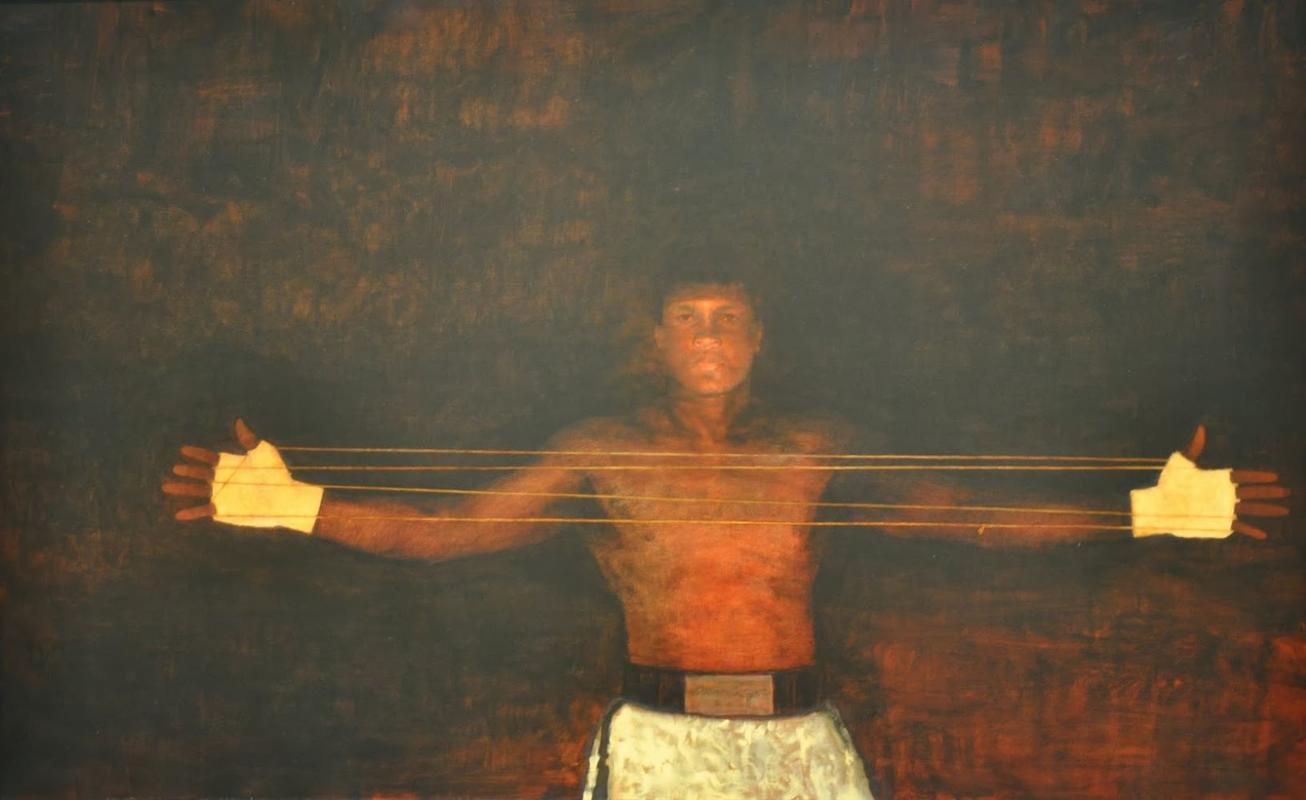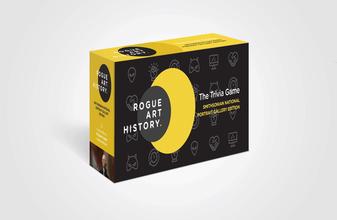More about Cat's Cradle
- All
- Info
- Shop

Sr. Editor
In Cat's Cradle, Henry Casselli paints boxing legend and American icon Muhammad Ali.
"Cat’s cradle" is a string game readers of a certain age may have learned in the schoolyard. Entwined in the legendary boxer’s fingers is a cat’s cradle, which symbolize the ropes of a boxing ring. One of the boxing strategies Ali popularized was known as the "rope-a-dope," and was made famous during the "Rumble in the Jungle," a historic match between Ali and then undefeated heavyweight world champion George Foreman. The match was, and still is, considered one of the most major sporting events of all time, attracting a world record 1 billion viewers globally, so it makes sense Casselli would choose this reference for a portrait of Ali.
Foreman was the favorite to win the fight, but Ali had a trick up his sleeve. After the first round, Ali began to lean against the ropes of the ring, covering his head but allowing Foreman to punch his arms and body. Meanwhile he took every chance he got to hit Foreman in the face. Not surprisingly, this tactic eventually tired Foreman out, allowing Ali a knockout in the eighth round, and securing his place as the world champion. The National Portrait Gallery also notes that, though the strings may seem an obvious nod to the "rope-a-dope" technique, "...the contrast between the delicate strings and Ali's powerful form prompts a more subtle reference to Ali's famous description of his boxing style, ‘Float like a butterfly, sting like a bee.’"
Ali chose Casselli himself to paint this portrait, as he was impressed with the artist's depictions of African American people from his New Orleans neighborhood. Ali may have also appreciated Casselli's honest and brutal published drawings of the war in Vietnam, where Casselli served for fourteen traumatic months and saw innumerable horrors. Casselli was there during the Tet offensive, an escalation by the Viet Cong and People's Army of Vietnam against the Army of the Republic of Vietnam and U.S. forces that resulted in huge casualties of American soldiers and led to more public outrage against the conflict back in the United States, and which the artist later depicted. Ali famously and publicly refused to be inducted into the army, which resulted in the revocation of his boxing license and a felony conviction (though his license was restored in 1970 and the conviction overturned by the Supreme Court in 1971, after four years of appeals and public anti-war campaigns). Of his decision to be a conscientious objector, which was praised by Rev. Martin Luther King, Jr., Ali said, "“My conscience won’t let me go shoot my brother, or some darker people, or some poor hungry people in the mud for big powerful America.”
In preparation for the portrait, in 1980, Casselli traveled to Las Vegas, where he spent 4 days with Ali and his entourage, who were there to support Ali one week before his infamous fight with Larry Holmes. Having previously had the idea to paint a cat's cradle, and noticing a boyishness in Ali's demeanor, Casselli asks the young athlete if he has ever played the game. Ali lights up and, in Casselli's words, "The childlike part of his personality showed. It made me think that this man played with his opponents, very much like a child playing with a toy." Casselli was also surprised that, in real life, Ali was nothing like the tough-talking aggressor he had seen promoting fights on television. Instead, Casselli found Ali to be rather soft-spoken and gentle. He notes that when fans approached Ali, they would stop just short of his person, as if there was "an invisible barrier." Though Ali would always reach out to these people, often turning his attention to any children or babies in the group, Casselli couldn't help but think that Ali was "a prisoner to the image that he has built." These consequences of being such a public persona as a fighter give another dimension to this portrait, as the string acts as a barrier between us and Ali, suggesting he might feel isolated behind the ropes.
Cat’s Cradle is one of fourteen images the National Gallery owns of Ali. It was gifted to the gallery by Sig Rogich, advertising and public relations businessman, political media consultant, and, appropriately, former Chairman of the Nevada State Athletic Commission and boxing commissioner.
Sources
- Brown, Deneen L. "‘Shoot them for what?’ How Muhammad Ali won his greatest fight." The Washington Post. June 16, 2008 https://www.washingtonpost.com/news/retropolis/wp/2018/06/15/shoot-them…
- Kemp, John R. "Henry Casselli." 64 Parishes. Louisiana Endowment for the Humanities. September 12, 2012. https://64parishes.org/entry/henry-casselli
- Perry, Warren. "Portrait of Muhammad Ali by Henry Casselli." National Portrait Gallery, https://npg.si.edu/blog/portrait-muhammad-ali-henry-casselli
- Casselli, Henry. "Artist Talk, pt. 1." Face-to-Face, from the National Portrait Gallery. Podcast. National Portrait Gallery, Smithsonian Institution. Recorded at NPG, September 24, 2010. https://podcasts.apple.com/us/podcast/henry-casselli-artist-talk-pt1












